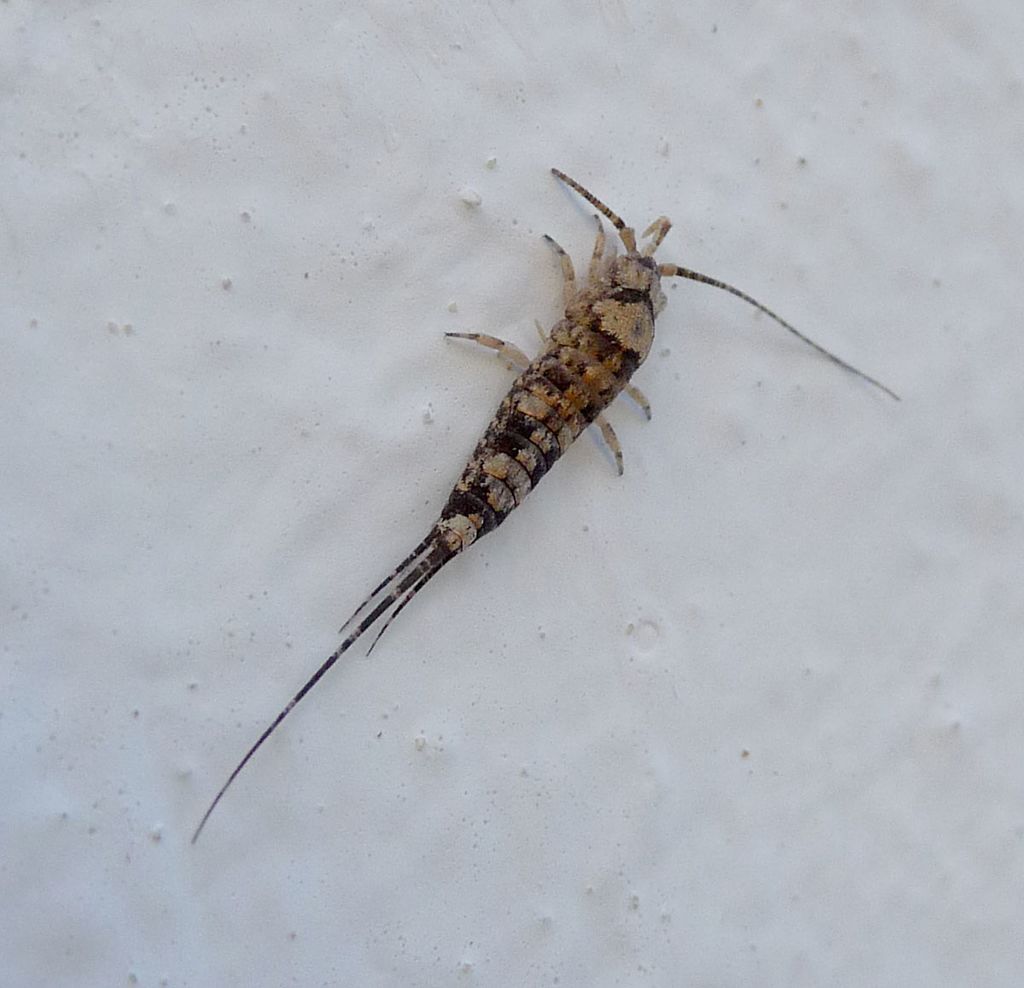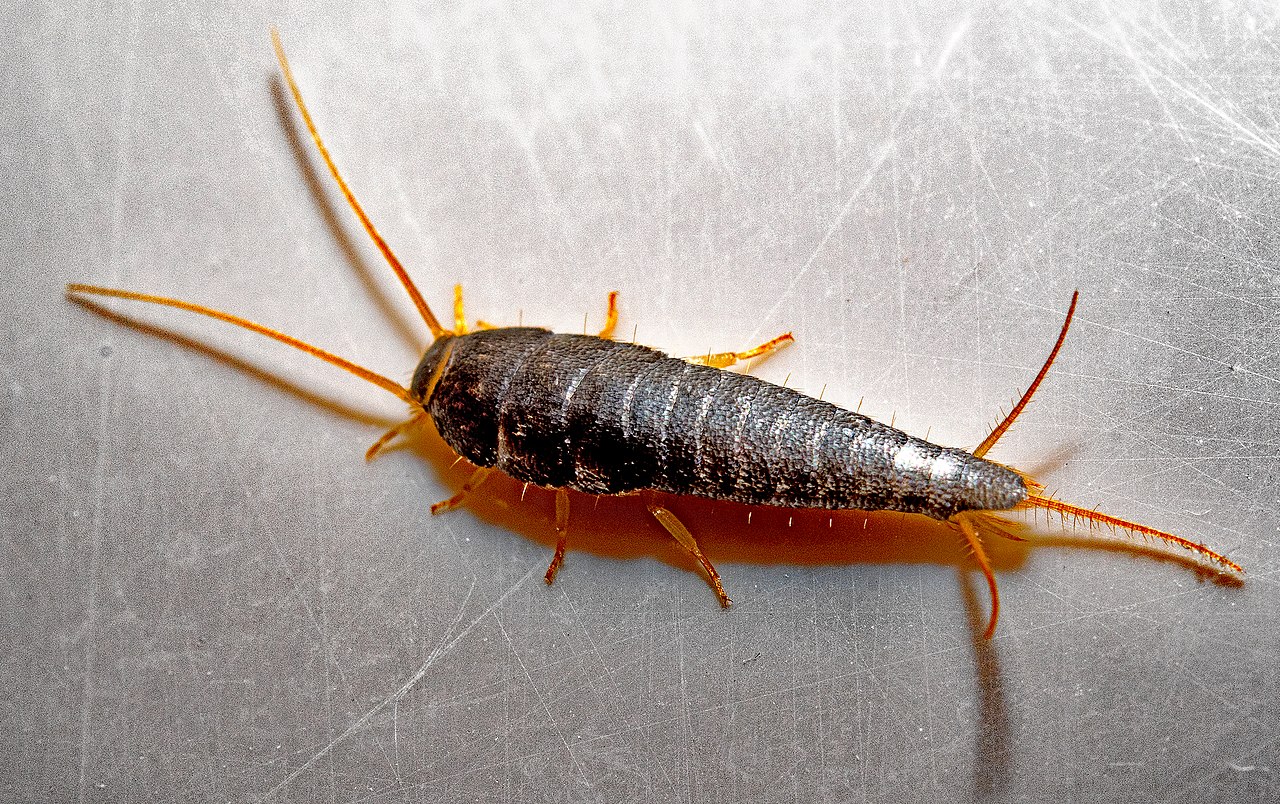Wingless insects
This page is about the Apterygota, small number of primitively wingless insects found in Britain and Ireland. This does not include the many more advanced insects which have secondarily lost their wings, or some groups now considered not to be insects (although closely related). The presence of wings as an aid to dispersal as well as hunting is considered one of the many reasons insects are so successful. Primitively wingless insects have never been very successful, and secondarily wingless insects have lost their wings for specific reasons.
Secondary wing loss
All of the fleas and lice (not covered here) are wingless as an adaptation to parasitism. Many barkflies or psocids are wingless as are some stoneflies - in New Zealand this habit has been linked to living in windy places above the treeline1. Some species in the flies and moths have adopted flightlessness Some insects have evolved winglessness in part of the life cycle as in the subterranean ants and termites where wings are a nuisance and only used in reproductive castes temporarily for dispersion. In some moths and wasps, the females are wingless and the males are winged.
Wingless insect-like arthropods
Until quite reecently three wingless arthropod groups were include as primitive members of the Insecta, largely because they have 6 legs. These are the springtails and the Diplura and Protura. These three are collectively grouped in the Entognatha reflecting the fact they have their mouth parts internally in contrast to the external mouthparts of insects. We now know they have independently adopted the six-legged habit
The Apterygota
With the removal of the entognaths, this subclass of insects now has only two living orders, the Archaeognatha and the Zygentoma, which are quite similar in appearance.
Archaeognatha These are commonly called the jumping-bristletails They are small insects with long arched bodies and three tail-like structures at the end of the abdomen with the central one much longer than those at the sides. They can run fast and jump out of harm's way. They have well developed compound eyes which meet in the midline and long whip-like antennae. The body, which tapers fairly uniformly from the head making little contrast between the thorax and abdomen, is covered with tiny scales quite like those of butterflies and moths.
The insects are up to 18mm long. There are seven species in Britain and Ireland, out of about 500 known globally.
They are most commonly seen on the seashore where Petrobious maritimus is common, and are poorly recorded from gardens, probably because few people will have looked for them. Dilta hibernica is the most likely to be seen in a garden.
Bristletail Dilta hirbenica Bristletail close-up to show scales.
Zygentoma is an order with about 550 species globally, and 2 in Britain and Ireland. You will find them referred to by the redundant name of Thysanura. They are commonly called silverfish and firebrats, and are similar in general form to bristletails, but are somewhat flattened, and the eyes are reduced or absent. The body is covered with scales giving them a silvery appearance, and the three "tails" are more similar in length, and the outer (cerci) are held at an angle to the body. The best-known species is Lepisma saccharina, 13-25mm long, once common in damper parts of houses, outbuildings and wood piles, but now much less often seen with the drying effect of central heating. The other species that may be seen is the firebrat Thermobia domestica which is common in warm buildings such as bakeries. This species is bred in quantity as food for pet lizards.

.jpg)
Two views of the common Silverfish Lepisma saccharina
Biology
Bristletails feed on algae, lichens and detritus, while silverfish are partial to sugars and starchy material.
Both mate in a primitive way, in which after a complex ritual, the male deposits a spermatophore on the substrate, which the female takes into her body. More advanced insects are internally fertilised. The nymphs look like smaller replicas of the adults. Silverfish can live up to 8 years, moulting up to 60 times in their lifetime, and continue to moult when sexually mature, unlike other insects.
Role of apterygotes in gardens
Silverfish are considered a pest in houses, and plenty of firms will offer to get rid of them for you. In practice they are shy nocturnal insects that do little damage. Neither group is well known in gardens, but they are likely to play a role as detritivores in processing dead plant material. More studies looking for them in gardens would be very worthwhile.
Reference
1. Graham A. McCulloch, G.A., Foster, B.J. Ingram. T and Waters, J.M. (2018) Insect wing loss is tightly linked to the treeline: evidence from a diverse stonefly assemblage Ecography 42, 4 https://doi.org/10.1111/ecog.04140
Further information
Online resource for bristletails
Page written by Steve Head
.jpg)

Wingless insects
This page is about the Apterygota, small number of primitively wingless insects found in Britain and Ireland. This does not include the many more advanced insects which have secondarily lost their wings, or some groups now considered not to be insects (although closely related). The presence of wings as an aid to dispoersal as well as hunting is considered one of the many reasons insects are so successful. primitively wingless i nsects have never been very successful, and secondarily wingless insects have lost their wings for specific reasons.
Secondary wing loss
All of the fleas and lice (not covered here) are wingless as an adaptation to parasitism. Many barkflies or psocids are wingless as are some stoneflies - in New Zealand this habit has been linked to living in windy places above the treeline1. Some species in the flies and moths have adopted flightlessness Some insects have evolved winglessness in part of the life cycle as in the subterranean ants and termites where wings are a nuisance and only used in reproductive castes temporarily for dispersion. In some moths and wasps, the females are wingless and the males are winged.
Wingless insect-like arthropods
Until quite reecently three wingless arthropod groups were include as primitive members of the Insecta, largely because they have 6 legs. These are the springtails and the Diplura and Protura. These three are collectively grouped in the Entognatha reflecting the fact they have their mouth parts internally in contrast to the external mouthparts of insects. We now know they have independently adopted the six-legged habit
The Apterygota
With the removal of the entognaths, this subclass of insects now has only two living orders, the Archaeognatha and the Zygentoma, which are quite similar in appearance.
Archaeognatha These are commonly called the jumping-bristletails They are small insects with long arched bodies and three tail-like structures at the end of the abdomen with the central one much longer than those at the sides. They can run fast and jump out of harm's way. They have well developed compound eyes which meet in the midline and long whip-like antennae. The body, which tapers fairly uniformly from the head making little contrast between the thorax and abdomen, is covered with tiny scales quite like those of butterflies and moths.
The insects are up to 18mm long. There are seven species in Britain and Ireland, out of about 500 known globally. They are most commonly seen on the seashore where Petrobious maritimus is common, and are poorly recorded from gardens, probably because few people will have looked for them. Dilta hibernica is the most likely to be seen in a garden.
.jpg)


.jpg)
Bristletail Dilta hirbenica Bristletail close-up to show scales.
Zygentoma is an order with about 550 species globally, and 2 in Britain and Ireland. You will find them referred to by the redundant name of Thysanura. They are commonly called silverfish and firebrats, and are similar in general form to bristletails, but are somewhat flattened, and the eyes are reduced or absent. The body is covered with scales giving them a silvery appearance, and the three "tails" are more similar in length, and the outer (cerci) are held at an angle to the body. The best-known species is Lepisma saccharina, 13-25mm long, once common in damper parts of houses, outbuildings and wood piles, but now much less often seen with the drying effect of central heating. The other species that may be seen is the firebrat Thermobia domestica which is common in warm buildings such as bakeries. This species is bred in quantity as food for pet lizards.
Two views of the common Silverfish Lepisma saccharina
Biology
Bristletails feed on algae, lichens and detritus, while silverfish are partial to sugars and starchy material.
Both mate in a primitive way, in which after a complex ritual, the male deposits a spermatophore on the substrate, which the female takes into her body. More advanced insects are internally fertilised. The nymphs look like smaller replicas of the adults. Silverfish can live up to 8 years, moulting up to 60 times in their lifetime, and continue to moult when sexually mature, unlike other insects.
Role of apterygotes in gardens
Silverfish are considered a pest in houses, and plenty of firms will offer to get rid of them for you. In practice they are shy nocturnal insects that do little damage. Neither group is well known in gardens, but they are likely to play a role as detritivores in processing dead plant material. More studies looking for them in gardens would be very worthwhile.
Reference
1. Graham A. McCulloch, G.A., Foster, B.J. Ingram. T and Waters, J.M. (2018) Insect wing loss is tightly linked to the treeline: evidence from a diverse stonefly assemblage Ecography 42, 4 https://doi.org/10.1111/ecog.04140
Further information
Online resource for bristletails
Page written by Steve Head
- Home
- Garden Wildlife
- Insects
- Wingless insects












